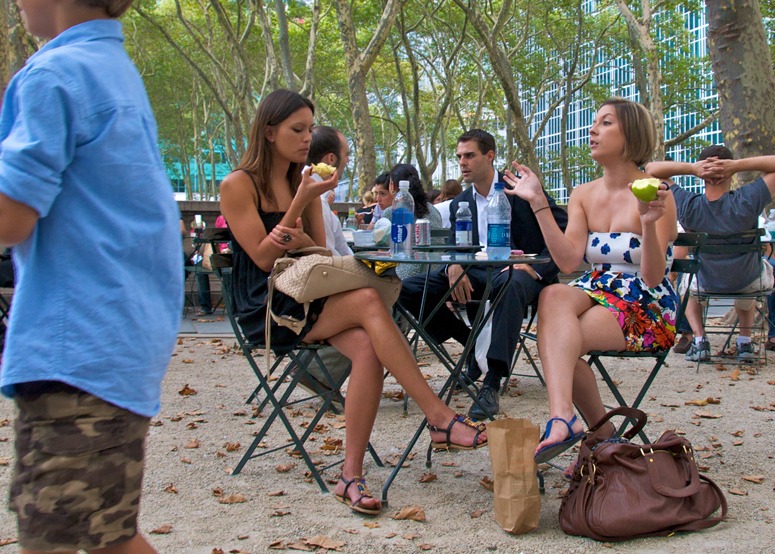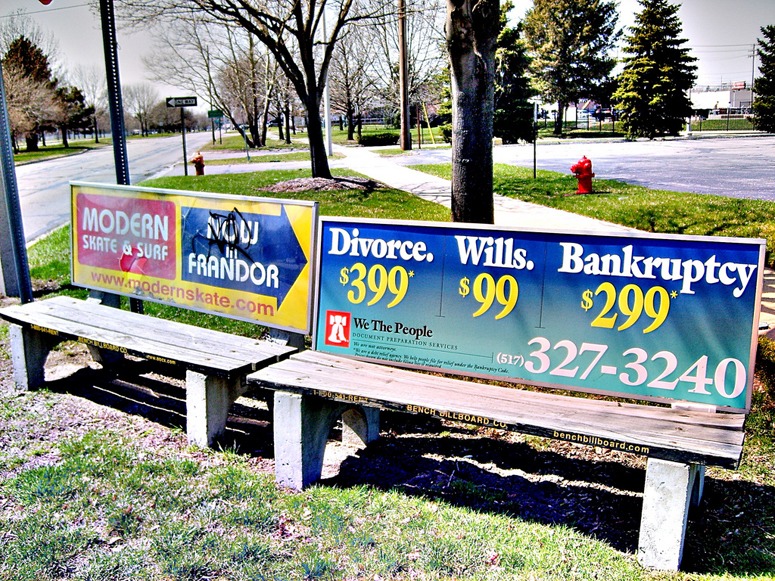The placing of benches and trees seems to bring out the worst in public authorities. Having created good SLOAP (= Space Left Over After Planning) they try to ameliorate the problem by calling up the landscapers and asking them to stick in a few benches and trees. Damn them! The correct policy is to treat urban trees not as ‘ornaments’ but as part of a multi-objective urban forestry programme. The objectives could and should include:
– improving the microclimate (eg by providing shelter and shade)
– improving views
– creating spatial containment
– helping to combat global warming
– producing fruit
– creating habitats for wildlife and increasing biodiversity
– producing firewood for local residents (eg from coppice trees)
– managing surface water (SUDS LID)
The below photograph shows Bryant Park in New York City. It was re-designed in the 1980s using ideas drawn from the greatest landscape planning theorist of the twentieth century: William H Whyte. The photographs shows urban seats which are NOT fixed in position, paving which is NOT sealed and trees which deserve the accolade ‘urban forestry’.

Top image courtesy RP Norris Lower image courtesy Ed Yourdon


I guess it is necessary in some urban settings for parks to have opening and closing hours?
[ http://www.bryantpark.org/plan-your-visit/hours.html ]
Gardens are the most obvious example where this is expected.
[ http://www.rbg.vic.gov.au/rbg-melbourne/visiting-us/open-hours ]
However it would be sad to lose parks that are unfenced fully accessible open space.
[ http://www.royalparks.org.uk/parks/hyde_park/ ]
The word ‘park’ derives from the verb ‘to impark’, meaning to fence off. So if the space is not protected in some way then it should not even be called a park. Fences and opening hours are a good means of protection. Or, as in London’s Hyde Park, you can have a park police force. But yes, yes, yes, it is also desirable to have unfenced and uncontrolled space. In London the best example of truly open space is the Thames beach.
Do you think they will have swimming [ http://www.bbc.co.uk/insideout/extra/series-1/london_beaches.shtml ] and skating by Tower Bridge if summers keep getting hotter and winters colder? [ http://upload.wikimedia.org/wikipedia/commons/9/98/Frost_Fair_of_1683.JPG ]
NOW, I feel the idea of William H Whyte is brilliant. He used observation and time-lapse photography to record the users on the plaza and give the the assessment of public open space.Then, we can clearly find what the trend of the spaces are and how they will affect the people in these spaces.
With the fast development of city, more and more public open spaces are needed, but not all of them are designed necessarily for users. There is an interesting question:if a public open space was designed ,but it became empty most of the time,why it should be designed?
Yes, WH Whyte was brilliant. But he said that with open space you must ‘use it or lose it’, so I guess he would not support the idea of empty open space. I would, providing it had other qualities.
Yes, it would be very interesting to explore and expand upon W H Whyte’s ideas and methodologies in more detail.[ http://vimeo.com/6821934 ]
The Spanish steps are the longest and widest steps in the whole of Europe.
[ http://www.youtube.com/watch?v=h8dI2qYmJ5c ] What was Pope Innocent XXII thinking?
I am equally amazed by the differences and by the similarities between Whyte’s world and our world.
Re Pope Innocent XXII, I guess he was thinking ‘what can I do to make Rome the world’s greatest city?’
That’s a joke those bench billboards. we don’t have them over here in the UK (…yet :/)
There is more than one way to design a seat and there is more than one way to design a square.
[ http://resource.wur.nl/en/wetenschap/detail/not_much_choice_on_a_bare_town_square/ ]
Not all seats are equally good, nor are all squares.
It is worth looking at what makes a good seat as well as what makes a good square!